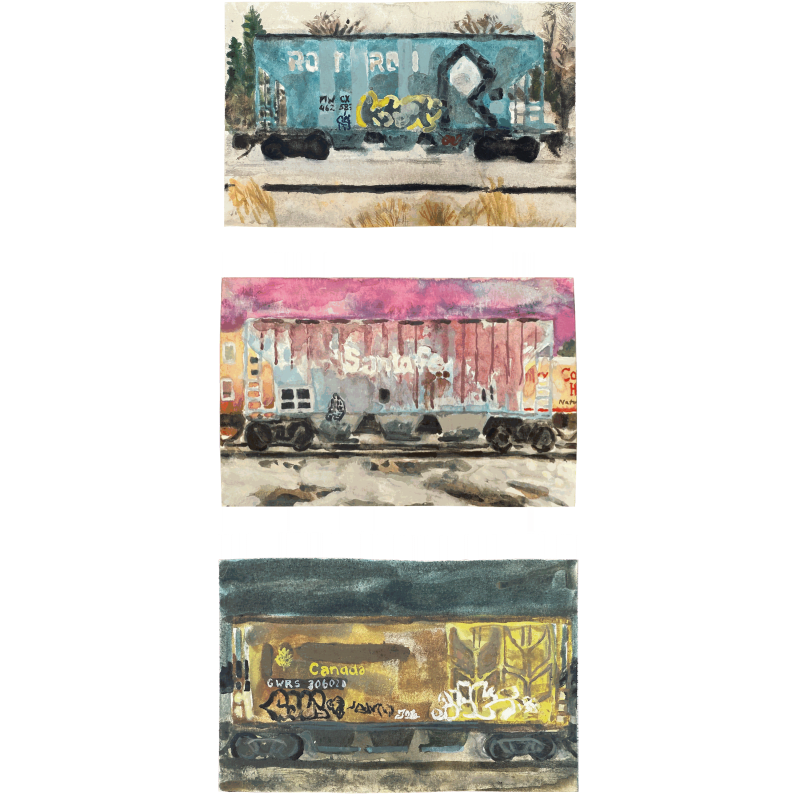Patrick Dunford paints landscapes in flux, focusing on his studies of trains and abandoned train yards to investigate themes of deindustrialization. Dunford is also curious about the challenges – and hubris – of trying to shape natural places to meet human needs. Caught between the wild and the human, Dunford’s impasto expanses of natural landscapes are broken up by tracks, spurs, chain link fences, blockish cars and trucks with wheels at odd angles, and occasional disconnected, laborious figures. Trains, once the avatar of industry and a symbol of modernity, now signify differently.
Dunford’s subjects often have a cartoon-like quality, reflecting his interest in artists like Philip Guston, and evokes a sense of arduous labor through the portrayal of his subjects and through gesture. Also like Guston, Dunford is generous in his paint handling, which involves working in and out of multiple, opten thick layers. He sees parallels between his themes and his oil process. “I scrape away at the paint, keep going, finding an image through a long process,” he says. His recent watercolor series depicts rail hoppers, a type of railroad freight car designed to transport mostly agricultural materials, that he sees in nearby Fargo and Moorhead, as well as in Winipeg. Unlike locomotives, hopper cars are rarely repainted when they change owners. Because of this, Dunford reads their exterior markings like a history book, and as a way to investigate the economic history of the rail lines. Dunford writes, “Ex Co-Op and Canadian Wheat Board cars now owned by private car holders show the reduction in farmer co-ops and public marketing boards for grain selling. There are also many cars still sporting the logos of fallen flag railroad lines that vanished with liberal railroad deregulation and the merger boom… As I get older, I am more interested in the passage of time that is written all over these hoppers in rust and faded logos.”
Most of Dunford’s paintings begin with drawings he works on as he often finds himself walking through these forgotten places of the Midwestern United States and Canada. Often painted from a slightly skewed bird’s eye perspective, empty rail lines snake across a parched landscape and through the run-down streets of a fading city. In some of Dunford’s paintings, the angle and subject matter evoke the nostalgic sensation of looking down at a child’s model train set. Dunford’s work, the landscape always prevails as the primary subject and most potent force over any portrayals of human intervention. Despite the notions of dilapidation and neglect that accompanies these abandoned sites, Dunford sees these post-industrial landscapes as hopeful, signifying the opportunity for and process of nature regaining some footing.
Patrick Dunford was born and raised in Winnipeg, Manitoba, Canada. Dunford completed his BFA at University of Manitoba, Winnipeg in 2005, and completed his MFA at Concordia University in Montreal in 2012. Dunford’s solo exhibitions include those at Norberg Hall (Calgary, Alberta); Best Practice (San Diego, California); Jarvis Hall Gallery (Calgary, Alberta); Galerie Laroche/Joncas (Montreal, Quebec); and Semai Gallery (Winnipeg, Manitoba). Dunford has been awarded Winnipeg Art Council Individual Artist Grant, the Faculty of Fine Arts Fellowship, Concordia University, Montreal, QC, and the Mitch Gowler Memorial Award, University of Manitoba, Winnipeg, MB. Dunford has also attended the Deep Bay Artist Residency, Manitoba Art Council, Wasagaming, Manitoba, and delivered a guest lecture at University of Indianapolis, Indianapolis, Indiana in 2020. Dunford lives and works between Moorhead, Minnesota and the Canadian Shield in Ontario, Canada.

